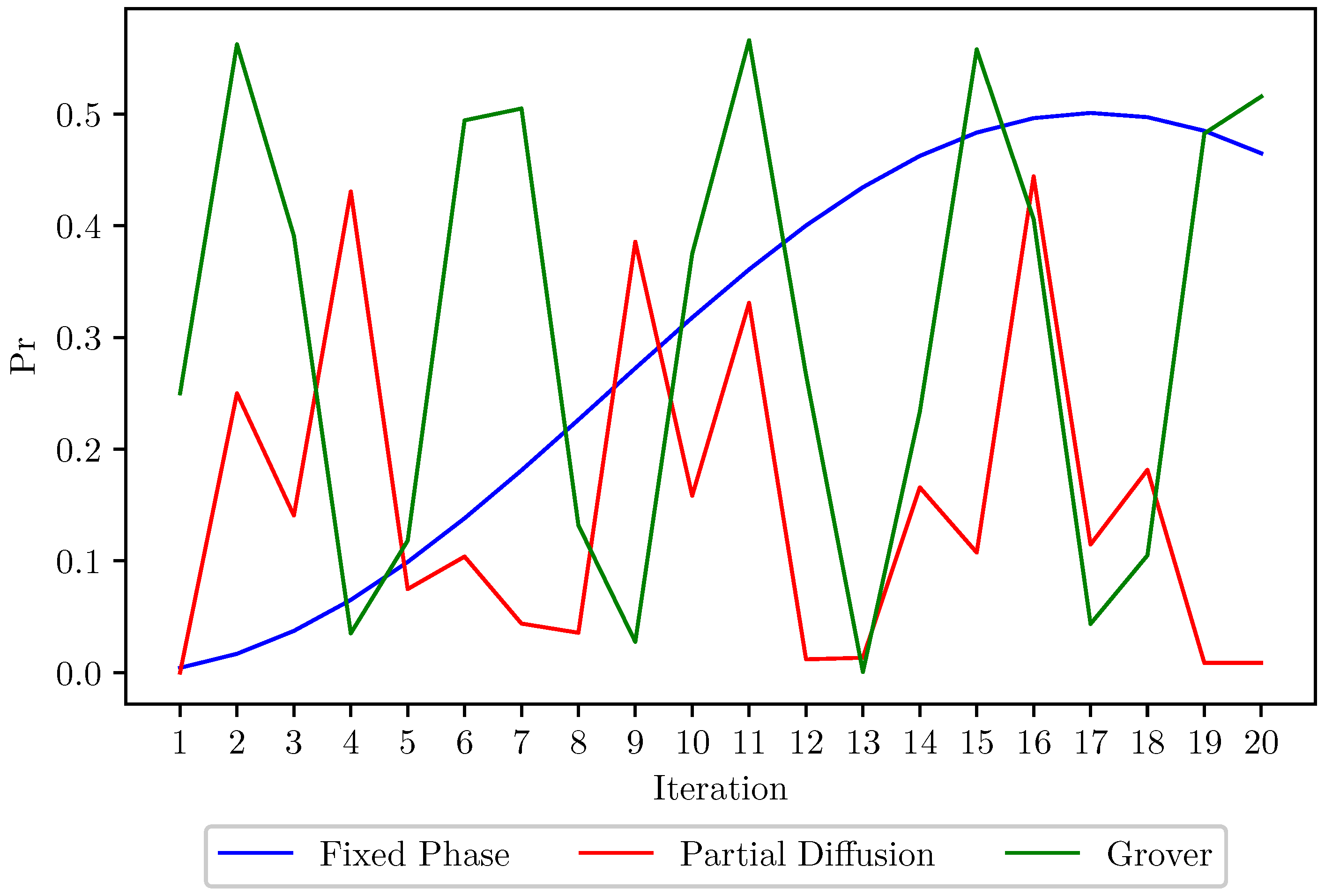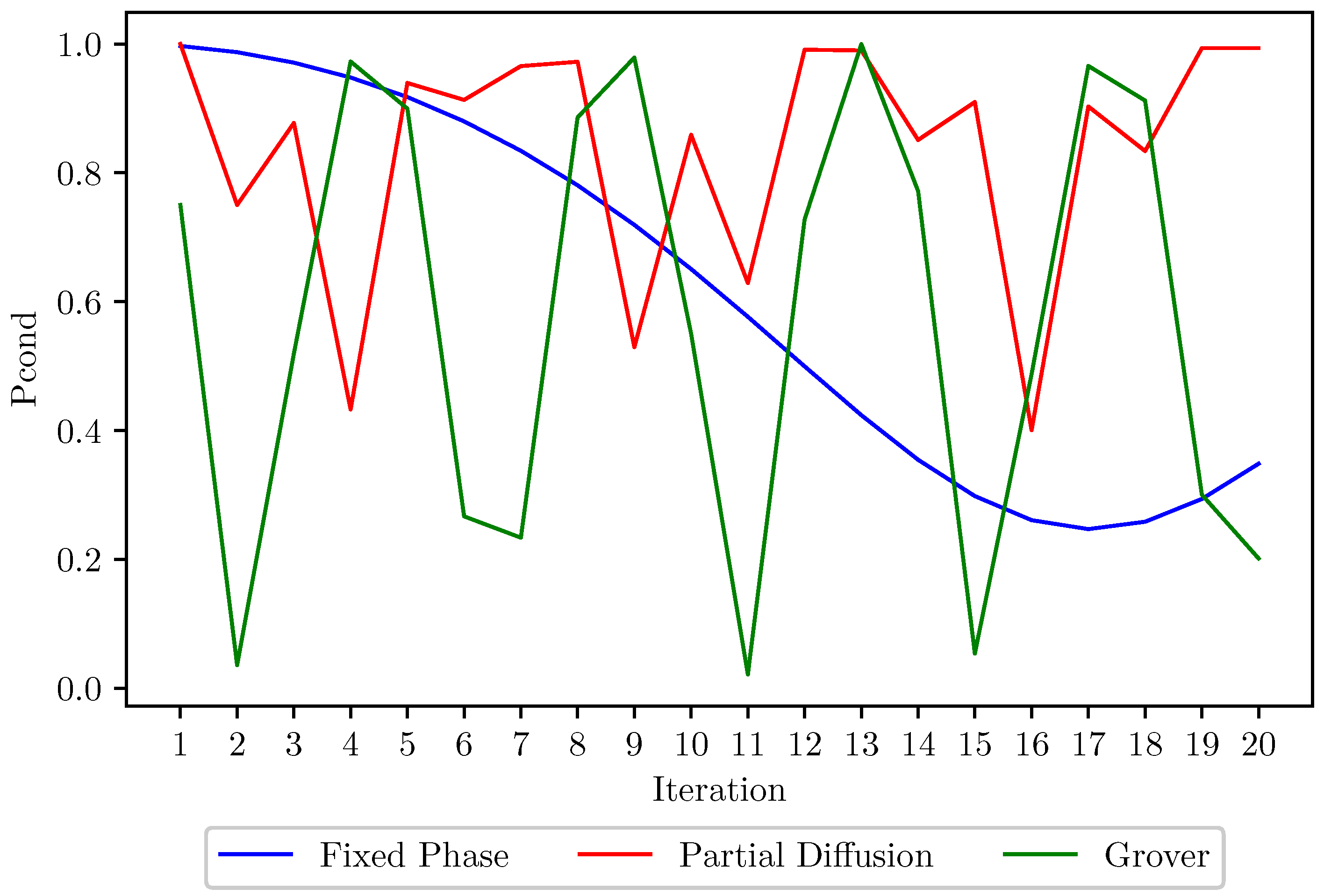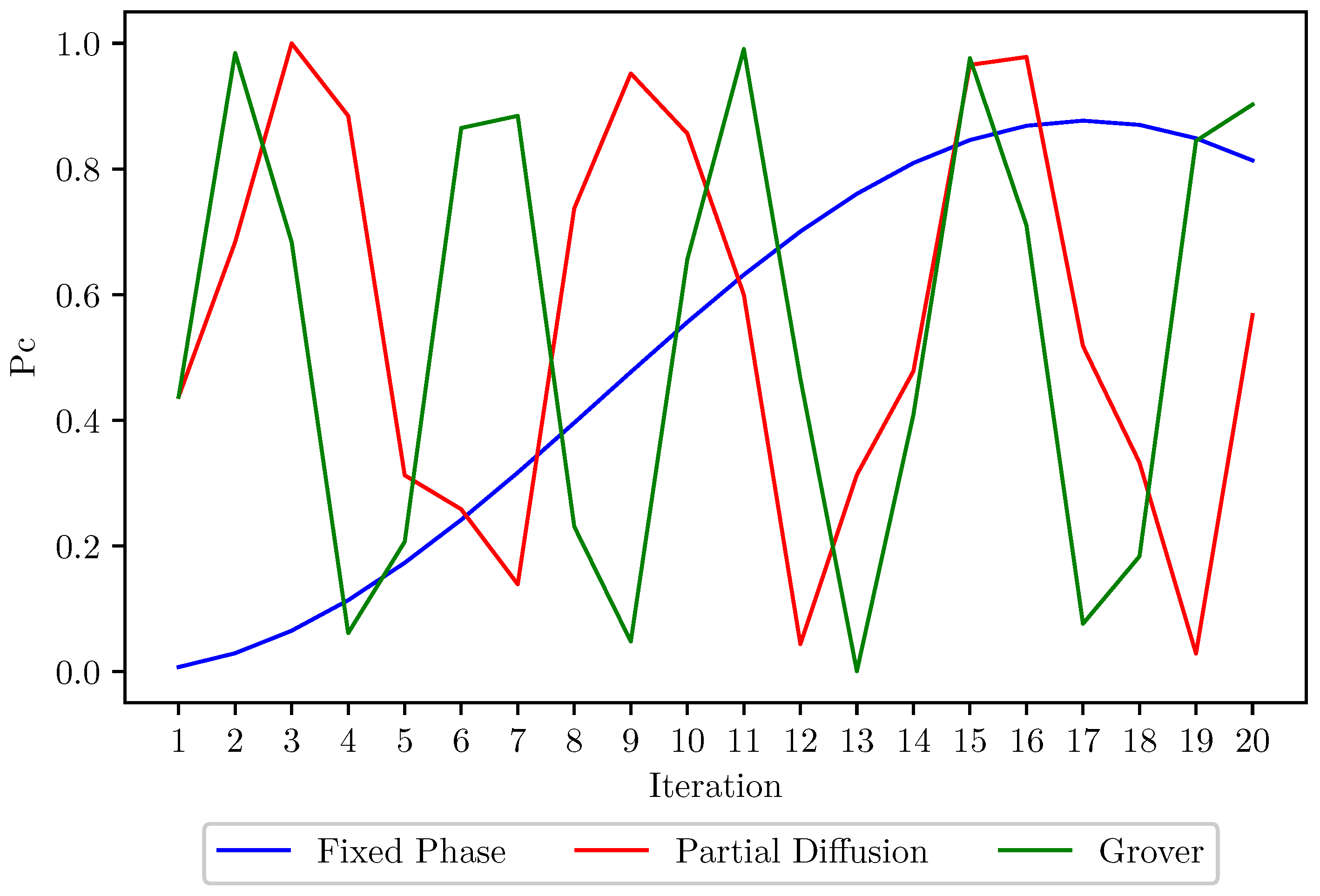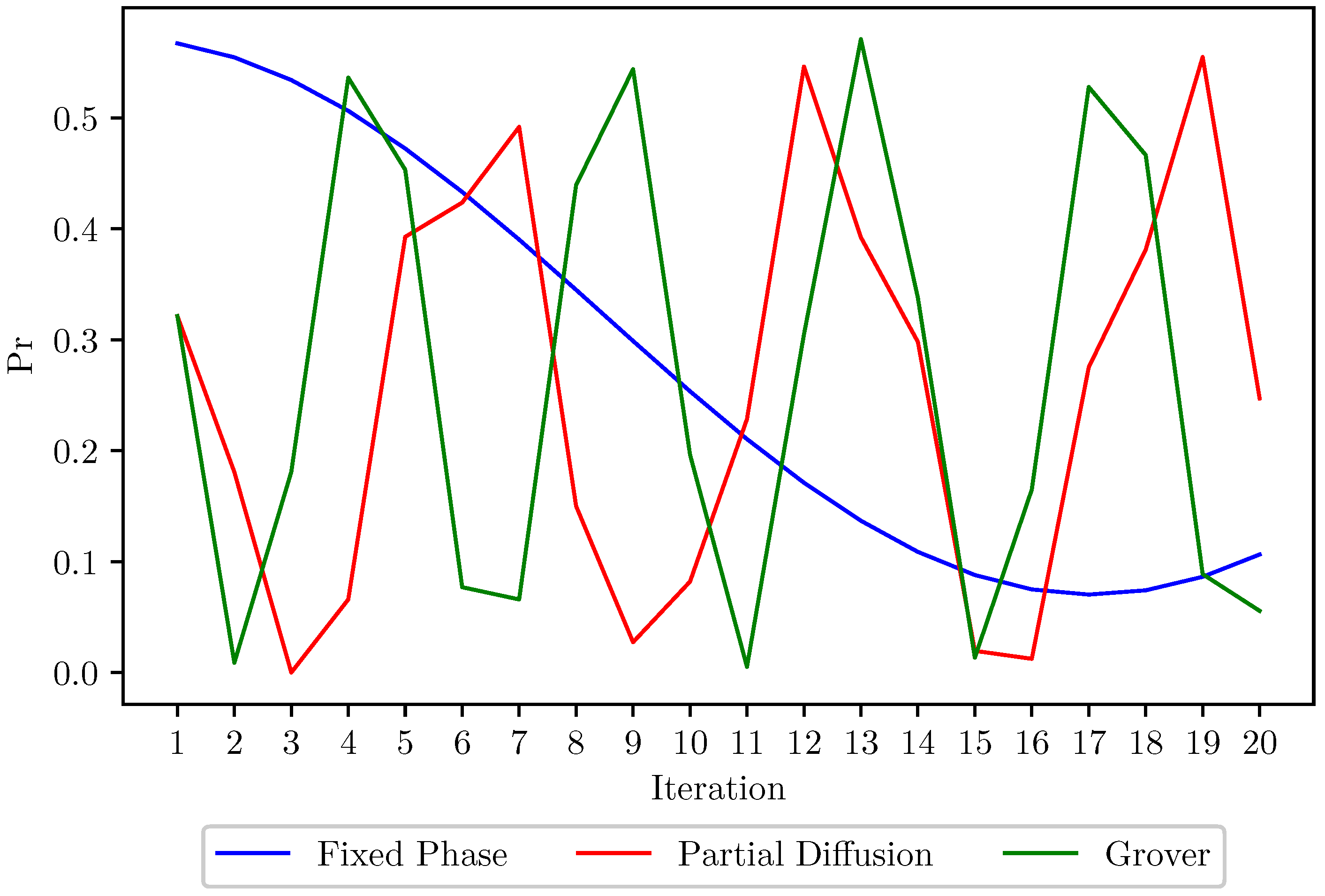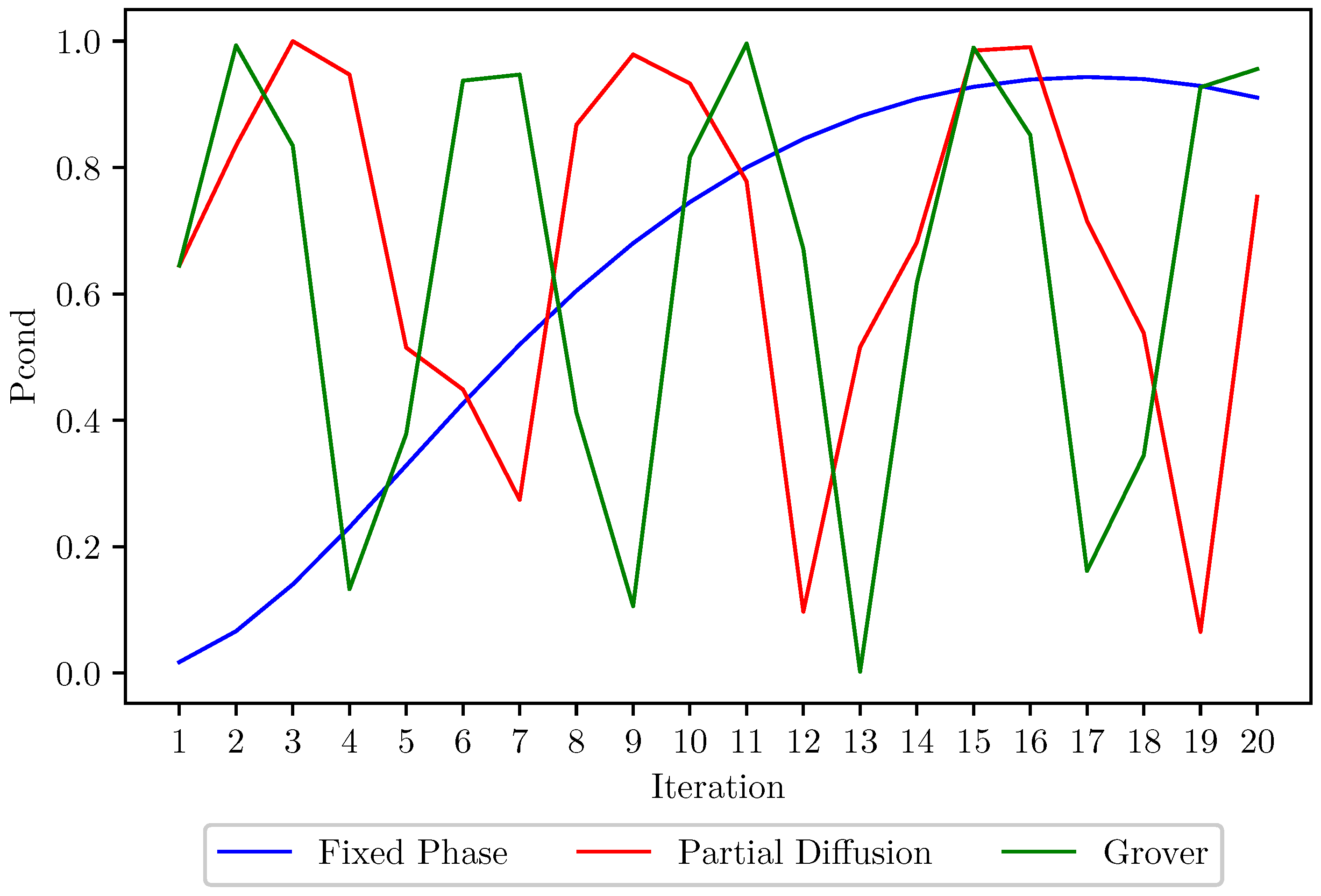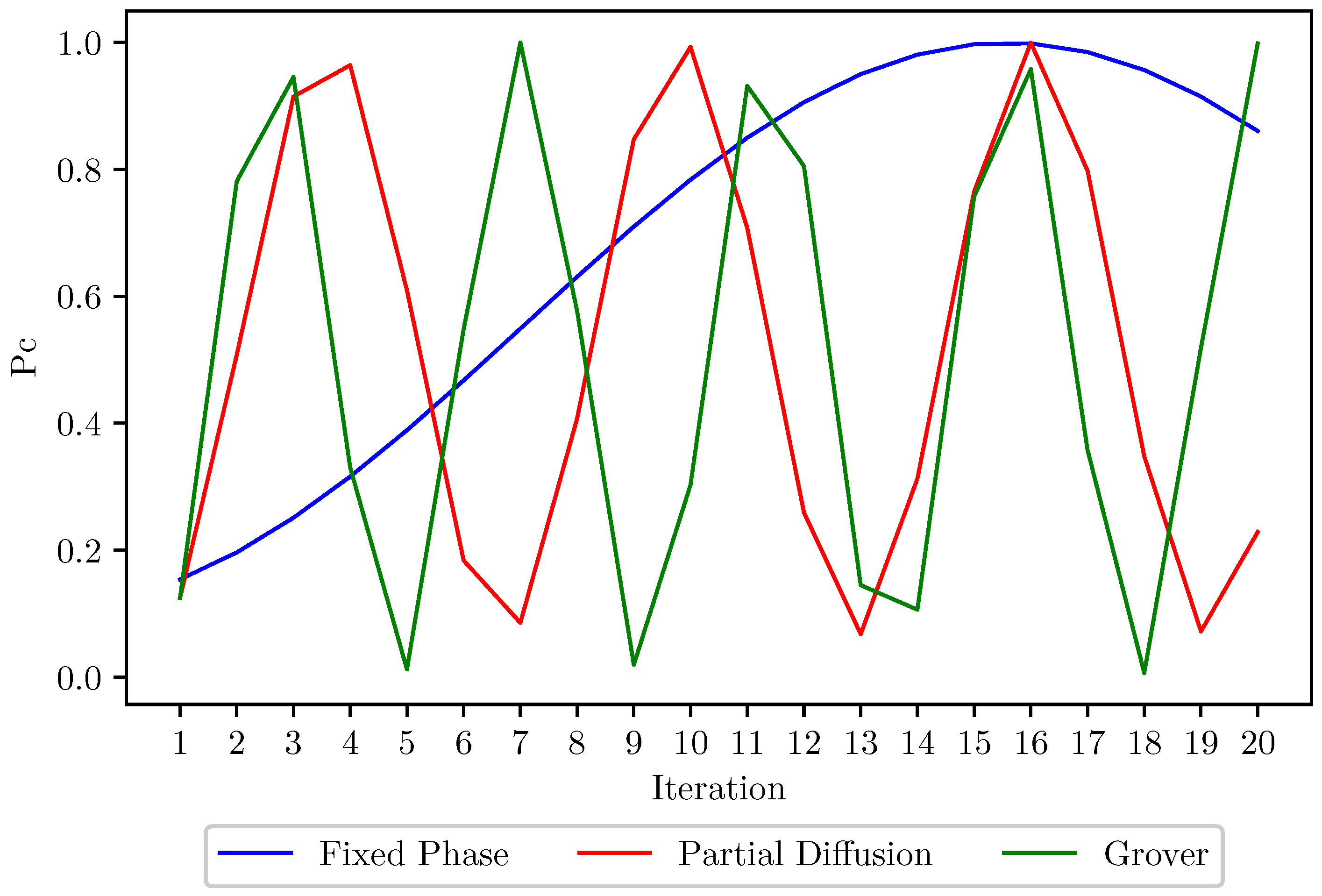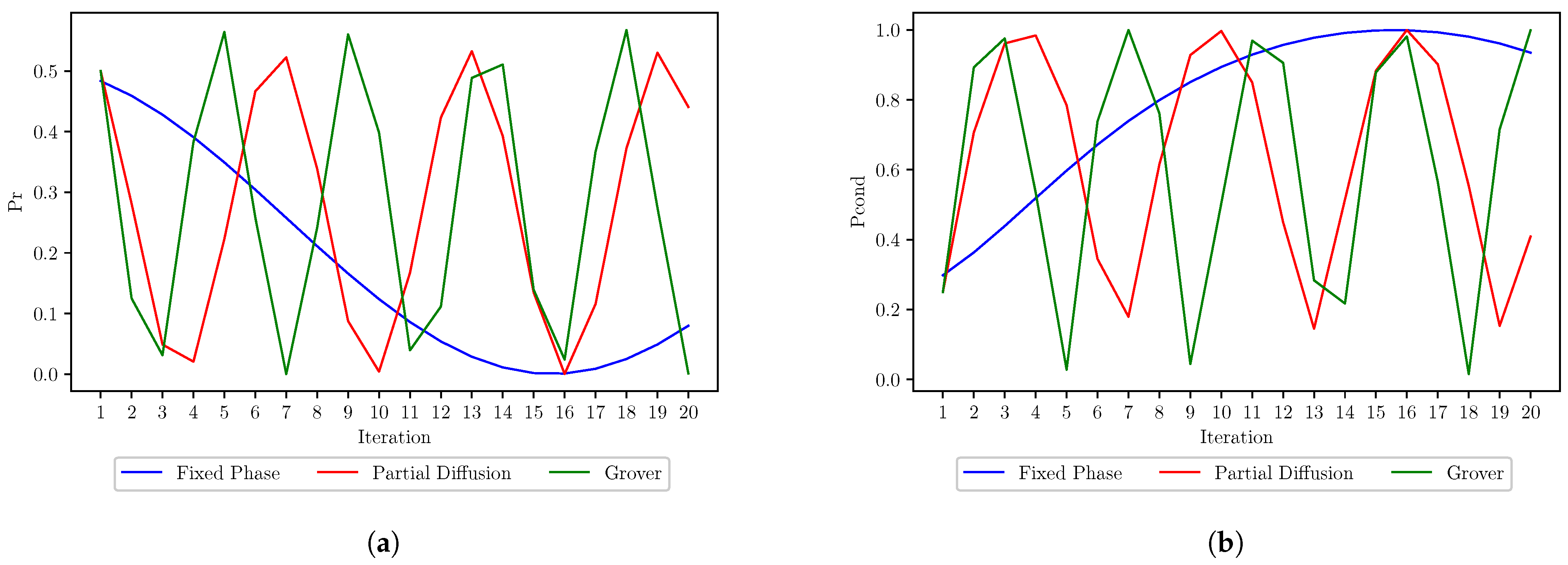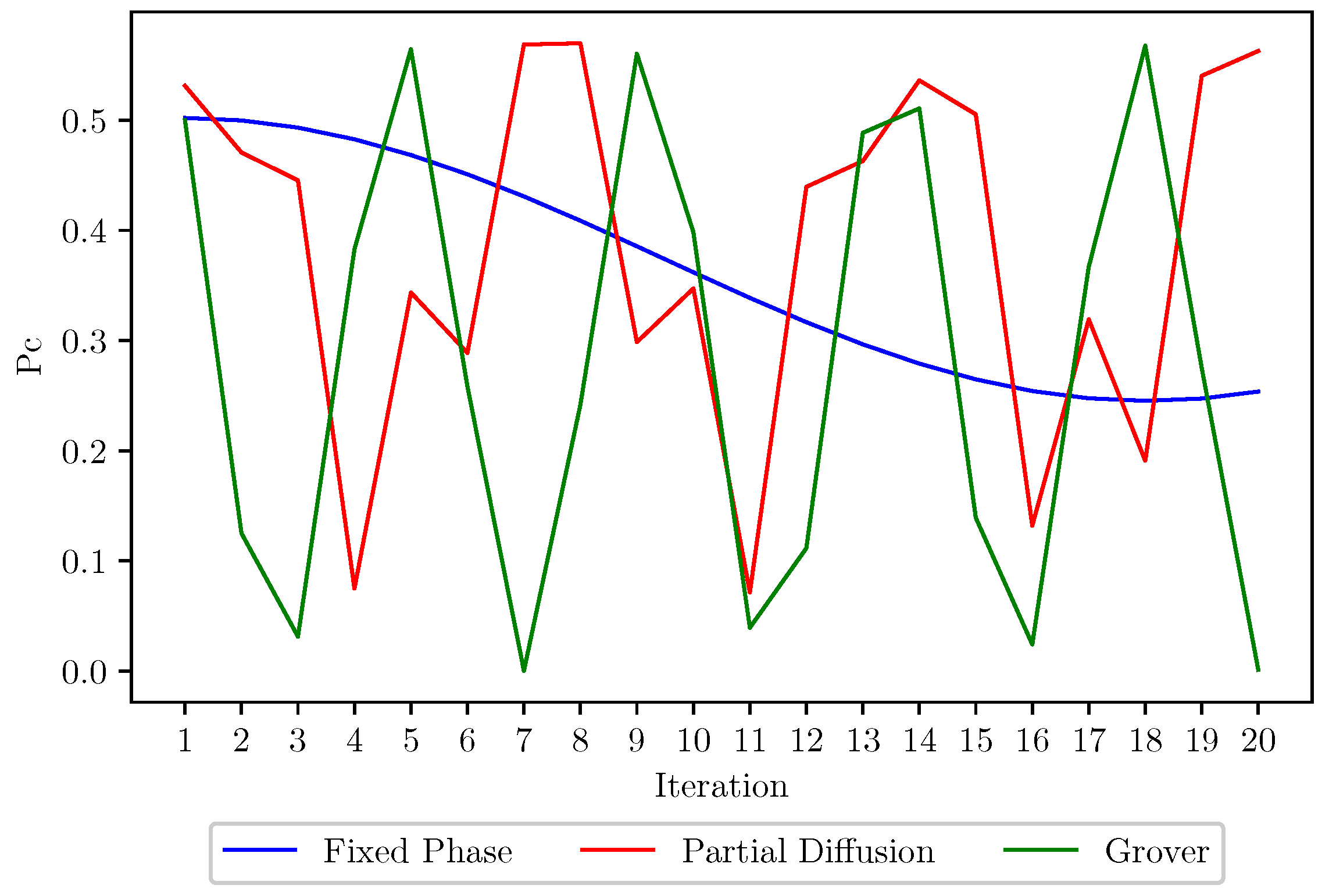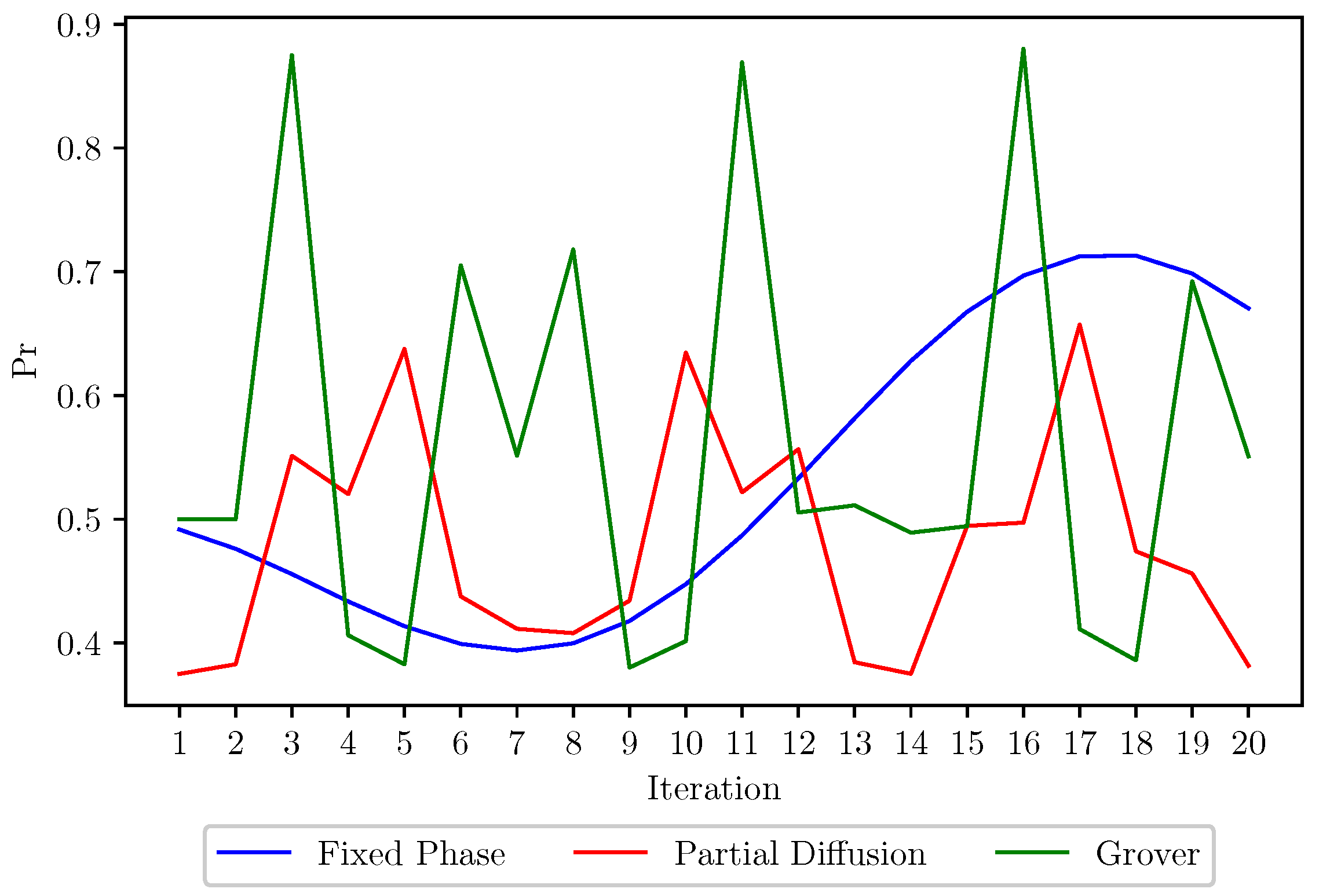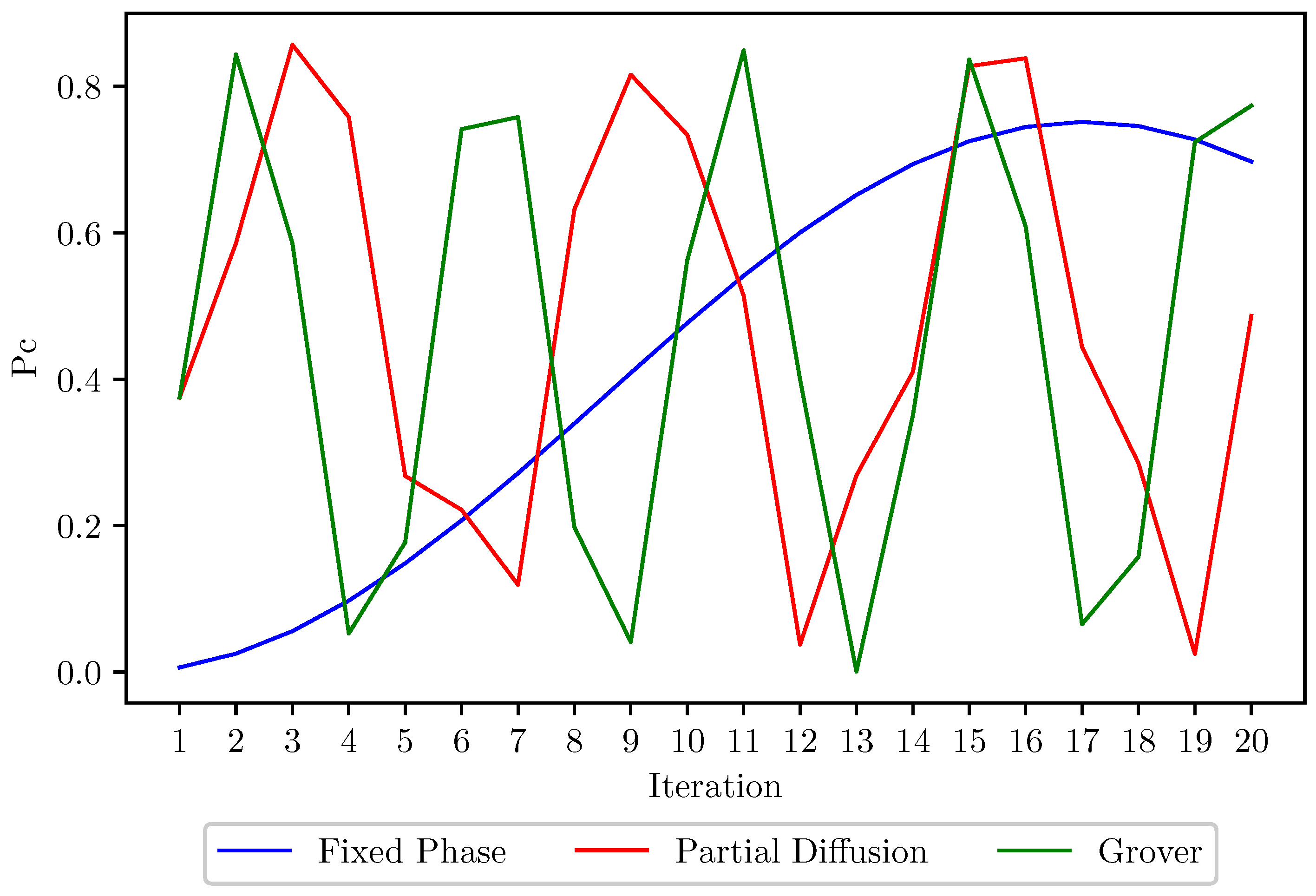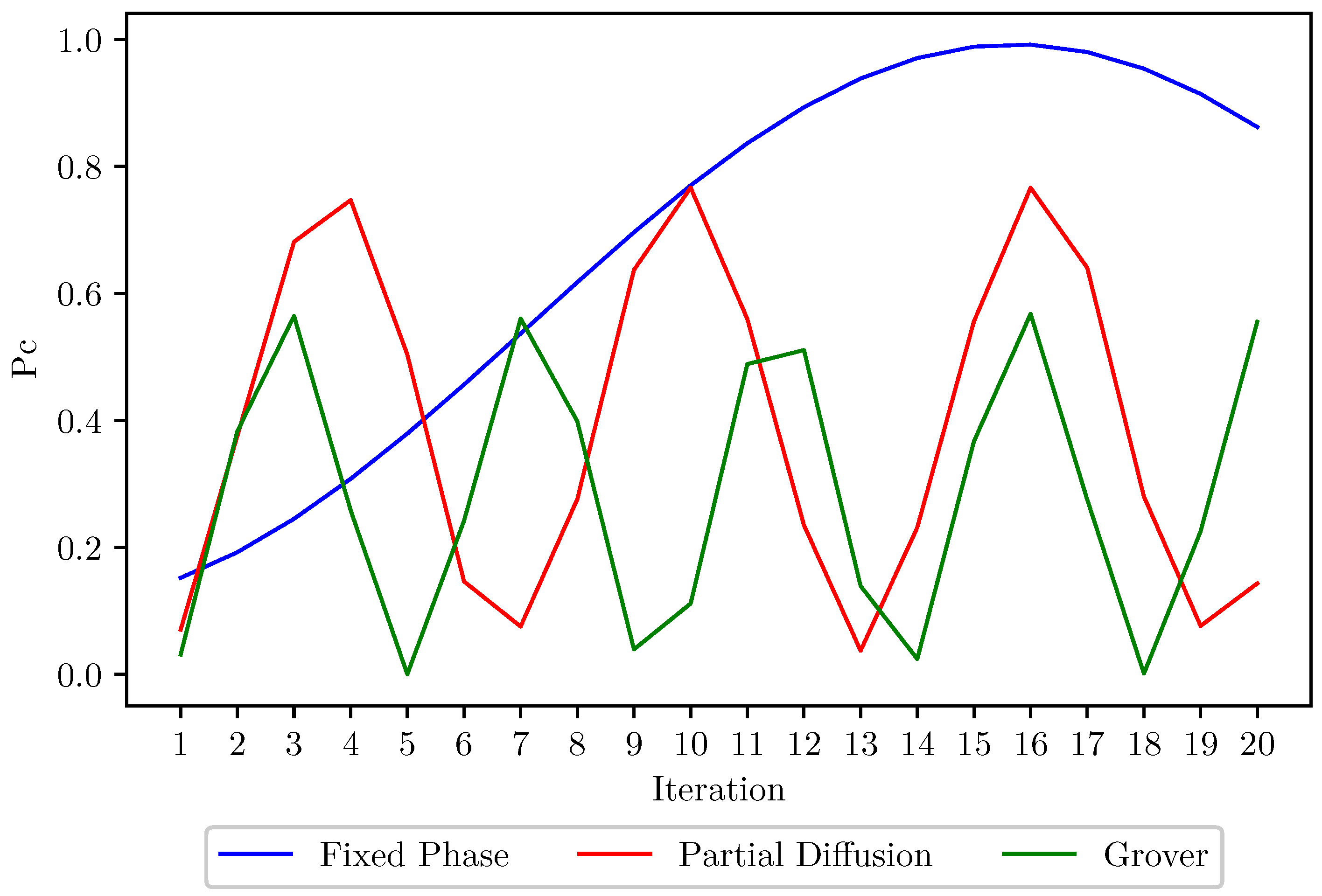Figure 1.
(a) Grover’s iterative operator applied to state ; (b) partial diffusion iterative operator applied to state .
Figure 1.
(a) Grover’s iterative operator applied to state ; (b) partial diffusion iterative operator applied to state .
Figure 2.
Fixed-phase iterative operator applied to state with a special oracle to eliminate state .
Figure 2.
Fixed-phase iterative operator applied to state with a special oracle to eliminate state .
Figure 3.
The probability of correct classification after 20 iterations of Grover’s, partial diffusion, and fixed-phase operators applied to .
Figure 3.
The probability of correct classification after 20 iterations of Grover’s, partial diffusion, and fixed-phase operators applied to .
Figure 4.
The probability of the irrelevant classification of after 20 iterations of Grover’s, partial diffusion, and fixed-phase operators applied to .
Figure 4.
The probability of the irrelevant classification of after 20 iterations of Grover’s, partial diffusion, and fixed-phase operators applied to .
Figure 5.
The conditional probability of classification after 20 iterations of Grover’s, partial diffusion, and fixed-phase operators applied to .
Figure 5.
The conditional probability of classification after 20 iterations of Grover’s, partial diffusion, and fixed-phase operators applied to .
Figure 6.
The probability of correct classification after 20 iterations of Grover’s, partial diffusion, and fixed-phase operators applied to .
Figure 6.
The probability of correct classification after 20 iterations of Grover’s, partial diffusion, and fixed-phase operators applied to .
Figure 7.
The probability of irrelevant classification after 20 iterations of Grover’s, partial diffusion, and fixed-phase operators applied to .
Figure 7.
The probability of irrelevant classification after 20 iterations of Grover’s, partial diffusion, and fixed-phase operators applied to .
Figure 8.
The conditional probability of classification after 20 iterations of Grover’s, partial diffusion, and fixed-phase operators are applied to .
Figure 8.
The conditional probability of classification after 20 iterations of Grover’s, partial diffusion, and fixed-phase operators are applied to .
Figure 9.
The probability of correct classification after 20 iterations of Grover’s, partial diffusion, and fixed-phase operators applied to .
Figure 9.
The probability of correct classification after 20 iterations of Grover’s, partial diffusion, and fixed-phase operators applied to .
Figure 10.
(a) The probability of irrelevant classification after 20 iterations of Grover’s, partial diffusion, and fixed-phase operators applied to . (b) The conditional probability of classification after 20 iterations of Grover’s, partial diffusion, and fixed-phase operators applied to .
Figure 10.
(a) The probability of irrelevant classification after 20 iterations of Grover’s, partial diffusion, and fixed-phase operators applied to . (b) The conditional probability of classification after 20 iterations of Grover’s, partial diffusion, and fixed-phase operators applied to .
Figure 11.
The probability of correct classification after 20 iterations of Grover’s, partial diffusion, and fixed-phase operators applied to , and , respectively.
Figure 11.
The probability of correct classification after 20 iterations of Grover’s, partial diffusion, and fixed-phase operators applied to , and , respectively.
Figure 12.
The probability of correct classification after 20 iterations of Grover’s, partial diffusion, and fixed-phase operators applied to , , and , respectively.
Figure 12.
The probability of correct classification after 20 iterations of Grover’s, partial diffusion, and fixed-phase operators applied to , , and , respectively.
Figure 13.
The probability of correct classification after 20 iterations of Grover’s, partial diffusion, and fixed-phase operators applied to , , and , respectively.
Figure 13.
The probability of correct classification after 20 iterations of Grover’s, partial diffusion, and fixed-phase operators applied to , , and , respectively.
Figure 14.
The probability of correct classification after 20 iterations of Grover’s, partial diffusion, and fixed-phase operators applied to .
Figure 14.
The probability of correct classification after 20 iterations of Grover’s, partial diffusion, and fixed-phase operators applied to .
Figure 15.
The probability of irrelevant classification after 20 iterations of Grover’s, partial diffusion, and fixed-phase operators applied to .
Figure 15.
The probability of irrelevant classification after 20 iterations of Grover’s, partial diffusion, and fixed-phase operators applied to .
Figure 16.
The probability of correct classification after 20 iterations of Grover’s, partial diffusion, and fixed-phase operators applied to .
Figure 16.
The probability of correct classification after 20 iterations of Grover’s, partial diffusion, and fixed-phase operators applied to .
Figure 17.
The probability of irrelevant classification after 20 iterations of Grover’s, partial diffusion, and fixed-phase operators applied to .
Figure 17.
The probability of irrelevant classification after 20 iterations of Grover’s, partial diffusion, and fixed-phase operators applied to .
Figure 18.
The conditional probability classification after 20 iterations of Grover’s, partial diffusion, and fixed-phase operators applied to .
Figure 18.
The conditional probability classification after 20 iterations of Grover’s, partial diffusion, and fixed-phase operators applied to .
Figure 19.
The probability of correct classification after 20 iterations of Grover’s, partial diffusion, and fixed-phase operators applied to .
Figure 19.
The probability of correct classification after 20 iterations of Grover’s, partial diffusion, and fixed-phase operators applied to .
Figure 20.
The probability of irrelevant classification after 20 iterations of Grover’s, partial diffusion, and fixed-phase operators applied to .
Figure 20.
The probability of irrelevant classification after 20 iterations of Grover’s, partial diffusion, and fixed-phase operators applied to .
Table 1.
The calculated probability of classification after various iterations of Grover’s operator applied to .
Table 1.
The calculated probability of classification after various iterations of Grover’s operator applied to .
| Iteration | 1 | 3 | 5 | 7 | 9 | 11 | 13 | 15 | 17 |
|---|
| 0.5625 | 0.316409 | 0.793212 | 0.115489 | 0.951768 | 0.009206 | 0.9991457 | 0.023699 | 0.923686 |
| 0.1875 | 0.293 | 0.088623 | 0.379 | 0.020671 | 0.42462 | 0.00036612 | 0.41841 | 0.032706 |
| 0.25 | 0.391 | 0.118164 | 0.505 | 0.027561 | 0.56616 | 0.00048 | 0.55788 | 0.043608 |
| P | 0.75 | 0.609377 | 0.881835 | 0.494569 | 0.972439 | 0.433826 | 0.999512 | 0.442109 | 0.956392 |
| 0.75 | 0.519234 | 0.899502 | 0.233514 | 0.978743 | 0.021221 | 0.999634 | 0.053605 | 0.965803 |
Table 2.
The calculated probability of classification after various iterations of the partial diffusion operator are applied to .
Table 2.
The calculated probability of classification after various iterations of the partial diffusion operator are applied to .
| Iteration | 1 | 3 | 5 | 7 | 9 | 11 | 13 | 15 | 17 |
|---|
| 1 | 0.753908 | 0.869157 | 0.92321 | 0.325121 | 0.420718 | 0.976736 | 0.811916 | 0.799331 |
| 0 | 0.105468 | 0.056076 | 0.03291 | 0.289233 | 0.248265 | 0.009971 | 0.080607 | 0.086001 |
| 0 | 0.140624 | 0.074768 | 0.04388 | 0.385644 | 0.33102 | 0.013294 | 0.107476 | 0.114668 |
| P | 1 | 0.859376 | 0.925233 | 0.95612 | 0.614354 | 0.668983 | 0.986706 | 0.892523 | 0.885332 |
| 1 | 0.877274 | 0.939393 | 0.96558 | 0.529208 | 0.628892 | 0.989895 | 0.909686 | 0.90286 |
Table 3.
The calculated probability of classification after various iterations of the fixed-phase operator are applied to .
Table 3.
The calculated probability of classification after various iterations of the fixed-phase operator are applied to .
| Iteration | 1 | 3 | 5 | 7 | 9 | 11 | 13 | 15 | 17 |
|---|
| 0.992577 | 0.934693 | 0.826701 | 0.683097 | 0.523177 | 0.36841 | 0.23959 | 0.153997 | 0.123162 |
| 0.003181 | 0.027988 | 0.074271 | 0.135816 | 0.204354 | 0.270681 | 0.32589 | 0.36258 | 0.37578 |
| 0.004242 | 0.037318 | 0.099028 | 0.181088 | 0.272472 | 0.360908 | 0.43452 | 0.48344 | 0.50104 |
| P | 0.995759 | 0.962682 | 0.900972 | 0.818913 | 0.727531 | 0.639091 | 0.56548 | 0.516577 | 0.498942 |
| 0.996805 | 0.970927 | 0.917566 | 0.834151 | 0.719113 | 0.57646 | 0.423693 | 0.29811 | 0.246847 |
Table 4.
The calculated probability of classification after various iterations of Grover’s operator applied to .
Table 4.
The calculated probability of classification after various iterations of Grover’s operator applied to .
| Iteration | 1 | 3 | 5 | 7 | 9 | 11 | 13 | 15 | 17 |
|---|
| 0.4375 | 0.683592 | 0.206784 | 0.884507 | 0.048231 | 0.990794 | 0.000854 | 0.976301 | 0.07631 |
| 0.241071 | 1.36 × 10 | 0.33996 | 4.95 × 10 | 0.40791 | 0.003945 | 0.42822 | 0.010157 | 0.39588 |
| 0.321428 | 1.81 × 10 | 0.45328 | 6.60 × 10 | 0.54388 | 0.00526 | 0.57096 | 0.013542 | 0.52784 |
| P | 0.678571 | 0.819195 | 0.546744 | 0.934004 | 0.456141 | 0.99474 | 0.429074 | 0.986458 | 0.472191 |
| 0.644738 | 0.834468 | 0.37821 | 0.947006 | 0.105737 | 0.996034 | 0.001991 | 0.989704 | 0.16161 |
Table 5.
The calculated probability of classification after various iterations of the partial diffusion operator applied to .
Table 5.
The calculated probability of classification after various iterations of the partial diffusion operator applied to .
| Iteration | 1 | 3 | 5 | 7 | 9 | 11 | 13 | 15 | 17 |
|---|
| 0.4375 | 0.999756 | 0.312591 | 0.139201 | 0.95196 | 0.600049 | 0.313381 | 0.965592 | 0.518318 |
| 0.241071 | 0.000104631 | 0.294603 | 0.36891 | 0.020589 | 0.171408 | 0.294264 | 0.014747 | 0.206436 |
| 0.321428 | 0.000139508 | 0.392804 | 0.49188 | 0.027452 | 0.228544 | 0.392352 | 0.019662 | 0.275248 |
| P | 0.678571 | 0.99986 | 0.607194 | 0.508111 | 0.972548 | 0.771457 | 0.607645 | 0.980338 | 0.724754 |
| 0.644738 | 0.999895 | 0.514812 | 0.273958 | 0.97883 | 0.777813 | 0.515731 | 0.984958 | 0.715164 |
Table 6.
The calculated probability of classification after various iterations of the fixed-phase operator applied to .
Table 6.
The calculated probability of classification after various iterations of the fixed-phase operator applied to .
| Iteration | 1 | 3 | 5 | 7 | 9 | 11 | 13 | 15 | 17 |
|---|
| 0.007423 | 0.065306 | 0.1733 | 0.316899 | 0.47682 | 0.63159 | 0.760411 | 0.845994 | 0.876842 |
| 0.4254 | 0.40059 | 0.3543 | 0.292758 | 0.22422 | 0.15789 | 0.102681 | 0.066003 | 0.052782 |
| 0.5672 | 0.53412 | 0.4724 | 0.390344 | 0.29896 | 0.21052 | 0.136908 | 0.088004 | 0.070376 |
| P | 0.432823 | 0.465896 | 0.5276 | 0.609657 | 0.70104 | 0.78948 | 0.863092 | 0.911997 | 0.929624 |
| 0.01715 | 0.140173 | 0.328469 | 0.519799 | 0.680161 | 0.800008 | 0.881031 | 0.927628 | 0.943222 |
Table 7.
The calculated probability of classification after various iterations of Grover’s operator applied to .
Table 7.
The calculated probability of classification after various iterations of Grover’s operator applied to .
| Iteration | 1 | 3 | 5 | 7 | 9 | 11 | 13 | 15 | 17 |
|---|
| 0.125 | 0.945312 | 0.012207 | 0.999786 | 0.019457 | 0.931267 | 0.144967 | 0.756615 | 0.3578498 |
| 0.375 | 0.0234 | 0.42333 | 0.00009 | 0.42024 | 0.029457 | 0.36645 | 0.104307 | 0.275208 |
| 0.5 | 3.13 × 10 | 0.56444 | 0.00012 | 0.56032 | 0.039276 | 0.4886 | 0.139076 | 0.366944 |
| P | 0.5 | 0.96875 | 0.435537 | 0.999878 | 0.439697 | 0.960724 | 0.511417 | 0.860922 | 0.633057 |
| 0.25 | 0.975807 | 0.028028 | 0.999908 | 0.04425 | 0.969339 | 0.283462 | 0.878843 | 0.565272 |
Table 8.
The calculated probability of classification after various iterations of the partial diffusion operator applied to .
Table 8.
The calculated probability of classification after various iterations of the partial diffusion operator applied to .
| Iteration | 2 | 4 | 6 | 8 | 10 | 12 | 14 | 16 | 18 |
|---|
| 0.507813 | 0.963898 | 0.183792 | 0.407252 | 0.992703 | 0.25926 | 0.312708 | 0.999593 | 0.347801 |
| 0.210936 | 0.015473 | 0.3498 | 0.254034 | 0.003127 | 0.31746 | 0.294555 | 0.000174594 | 0.279513 |
| 0.281248 | 0.02063 | 0.4664 | 0.338712 | 0.00417 | 0.42328 | 0.39274 | 0.000232792 | 0.372684 |
| P | 0.718749 | 0.97937 | 0.533592 | 0.661286 | 0.99583 | 0.57672 | 0.607263 | 0.999767 | 0.627314 |
| 0.706523 | 0.984202 | 0.344443 | 0.615848 | 0.99686 | 0.449542 | 0.514947 | 0.999825 | 0.554429 |
Table 9.
The calculated probability of classification after various iterations of the fixed-phase operator applied to .
Table 9.
The calculated probability of classification after various iterations of the fixed-phase operator applied to .
| Iteration | 2 | 4 | 6 | 8 | 10 | 12 | 14 | 16 | 18 |
|---|
| 0.196446 | 0.315928 | 0.467428 | 0.630589 | 0.783498 | 0.905619 | 0.980553 | 0.998238 | 0.956296 |
| 0.34437 | 0.293175 | 0.228246 | 0.158319 | 0.092787 | 0.040449 | 0.008334 | 0.000755 | 0.01873 |
| 0.45916 | 0.3909 | 0.304328 | 0.211092 | 0.123716 | 0.053932 | 0.011112 | 0.001007 | 0.024974 |
| P | 0.540816 | 0.609103 | 0.695674 | 0.788908 | 0.876285 | 0.946068 | 0.988888 | 0.998993 | 0.975027 |
| 0.36324 | 0.518678 | 0.671907 | 0.799319 | 0.894113 | 0.957245 | 0.991572 | 0.999244 | 0.98079 |
Table 10.
The calculated probability of classification after various iterations of Grover’s operator applied to =.
Table 10.
The calculated probability of classification after various iterations of Grover’s operator applied to =.
| Iteration | 1 | 2 | 4 | 6 | 8 | 9 | 10 | 12 | 14 | 16 | 18 |
|---|
| 0.5 | 0.125 | 0.382813 | 0.258299 | 0.241731 | 0.560308 | 0.398351 | 0.11147 | 0.51068 | 0.024093 | 0.567641 |
| 0 | 0.375 | 0.210936 | 0.036621 | 0.040374 | 0.059532 | 0.200094 | 0.3831 | 1.85 × 10 | 0.095706 | 0.046329 |
| 0.5 | 0.5 | 0.406246 | 0.705081 | 0.717894 | 0.380162 | 0.401554 | 0.50543 | 0.489135 | 0.880206 | 0.386029 |
| P | 0.5 | 0.5 | 0.593749 | 0.29492 | 0.282105 | 0.61984 | 0.598445 | 0.49457 | 0.510865 | 0.119799 | 0.61397 |
| 1 | 0.25 | 0.644739 | 0.875828 | 0.856883 | 0.903956 | 0.665643 | 0.225388 | 0.999638 | 0.201111 | 0.924542 |
Table 11.
The calculated probability of classification after various iterations of partial diffusion operator applied to = .
Table 11.
The calculated probability of classification after various iterations of partial diffusion operator applied to = .
| Iteration | 1 | 3 | 5 | 7 | 8 | 9 | 11 | 13 | 15 | 17 |
|---|
| 0.53125 | 0.445434 | 0.343551 | 0.56872 | 0.5698587 | 0.298609 | 0.071294 | 0.462981 | 0.505331 | 0.31918 |
| 0.09375 | 0.003296 | 0.018919 | 0.019855 | 0.0222012 | 0.267186 | 0.40695 | 0.152529 | 0.0000444 | 0.023664 |
| 0.375 | 0.551266 | 0.637529 | 0.411425 | 0.4079412 | 0.434206 | 0.52173 | 0.384489 | 0.494624 | 0.657154 |
| P | 0.625 | 0.44873 | 0.36247 | 0.588575 | 0.59205985 | 0.565795 | 0.478244 | 0.61551 | 0.505375 | 0.342845 |
| 0.85 | 0.992655 | 0.947806 | 0.966266 | 0.9625018 | 0.527769 | 0.149075 | 0.752191 | 0.999912 | 0.930977 |
Table 12.
The calculated probability of classification after various iterations of fixed-phase operator applied to .
Table 12.
The calculated probability of classification after various iterations of fixed-phase operator applied to .
| Iteration | 1 | 3 | 5 | 7 | 9 | 11 | 13 | 15 | 17 | 20 |
|---|
| 0.50208 | 0.493286 | 0.468421 | 0.430837 | 0.385569 | 0.338707 | 0.296541 | 0.264731 | 0.24755 | 0.253647 |
| 0.006255 | 0.051039 | 0.118029 | 0.175248 | 0.196656 | 0.174354 | 0.121959 | 0.067608 | 0.039999 | 0.076005 |
| 0.491665 | 0.455679 | 0.413549 | 0.393918 | 0.417776 | 0.486944 | 0.581499 | 0.667658 | 0.712449 | 0.670355 |
| P | 0.508335 | 0.544325 | 0.58645 | 0.606085 | 0.582225 | 0.513061 | 0.4185 | 0.332339 | 0.28755 | 0.329652 |
| 0.987696 | 0.906234 | 0.79874 | 0.710853 | 0.662234 | 0.660169 | 0.70858 | 0.796569 | 0.860897 | 0.769439 |
Table 13.
The calculated probability of classification after various iterations of Grover’s operator applied to .
Table 13.
The calculated probability of classification after various iterations of Grover’s operator applied to .
| Iteration | 1 | 2 | 3 | 5 | 7 | 9 | 11 | 13 | 15 | 20 |
|---|
| 0.374999 | 0.8437483 | 0.585939 | 0.177251 | 0.758147 | 0.041342 | 0.849251 | 7.32E-04 | 0.836828 | 0.773596 |
| 0.125001 | 0.031251002 | 0.195312 | 0.41064 | 0.011017 | 0.240375 | 0.025334 | 0.49962 | 0.037761 | 0.007781 |
| 0.500001 | 0.125001 | 0.218749 | 0.412105 | 0.230837 | 0.718285 | 0.125414 | 0.49962 | 0.125411 | 0.2186211 |
| P | 0.5 | 0.8749993 | 0.781251 | 0.587891 | 0.769164 | 0.281717 | 0.874585 | 0.500352 | 0.874589 | 0.781377 |
| 0.749998 | 0.96428454 | 0.750001 | 0.301503 | 0.985677 | 0.14675 | 0.971033 | 0.001464 | 0.956824 | 0.990041 |
Table 14.
The calculated probability of classification after various iterations of partial diffusion operator applied to .
Table 14.
The calculated probability of classification after various iterations of partial diffusion operator applied to .
| Iteration | 1 | 3 | 5 | 7 | 9 | 11 | 13 | 15 | 17 | 20 |
|---|
| 0.374999 | 0.856935 | 0.267939 | 0.119307 | 0.815967 | 0.514329 | 0.26862 | 0.82765 | 0.44427 | 0.486439 |
| 0.125001 | 0.012207 | 0.36423 | 0.44004 | 0.05469 | 0.079686 | 0.160965 | 0.00013 | 0.272133 | 0.088551 |
| 0.500001 | 0.130857 | 0.367806 | 0.440678 | 0.129344 | 0.405986 | 0.570415 | 0.17222 | 0.283596 | 0.425011 |
| P | 0.5 | 0.869142 | 0.632169 | 0.559347 | 0.870657 | 0.594015 | 0.429585 | 0.82778 | 0.716404 | 0.57499 |
| 0.749998 | 0.985955 | 0.423841 | 0.213296 | 0.937185 | 0.865852 | 0.625301 | 0.999843 | 0.62014 | 0.845996 |
Table 15.
The calculated probability of classification after various iterations of fixed-phase operator applied to .
Table 15.
The calculated probability of classification after various iterations of fixed-phase operator applied to .
| Iteration | 1 | 3 | 5 | 7 | 9 | 11 | 13 | 15 | 17 | 20 |
|---|
| 0.006362 | 0.055978 | 0.148544 | 0.27163 | 0.408708 | 0.541359 | 0.651781 | 0.725138 | 0.75158 | 0.697362 |
| 0.49365 | 0.44526 | 0.36099 | 0.26115 | 0.166713 | 0.092736 | 0.044949 | 0.020801 | 0.0139 | 0.026479 |
| 0.500013 | 0.498737 | 0.49044 | 0.46722 | 0.424583 | 0.365906 | 0.303269 | 0.254061 | 0.23452 | 0.276159 |
| P | 0.500012 | 0.501238 | 0.509535 | 0.53278 | 0.575421 | 0.634095 | 0.69673 | 0.745939 | 0.76548 | 0.723841 |
| 0.012724 | 0.11168 | 0.29153 | 0.509835 | 0.710276 | 0.853751 | 0.935486 | 0.972114 | 0.981842 | 0.963419 |
Table 16.
The calculated probability of classification after various iterations of Grover’s operator applied to .
Table 16.
The calculated probability of classification after various iterations of Grover’s operator applied to .
| Iteration | 2 | 4 | 6 | 8 | 10 | 12 | 14 | 16 | 18 | 20 |
|---|
| 0.382813 | 0.258299 | 0.241731 | 0.398351 | 0.11147 | 0.51068 | 0.024093 | 0.567641 | 0.001098 | 0.555229 |
| 0.210936 | 0.036621 | 0.0404 | 0.200094 | 0.3831 | 0.000185 | 0.095706 | 0.046329 | 0.44805 | 0.066711 |
| 0.406246 | 0.705081 | 0.717894 | 0.401554 | 0.50543 | 0.489135 | 0.880206 | 0.386029 | 0.55087 | 0.378061 |
| P | 0.593749 | 0.29492 | 0.282105 | 0.598445 | 0.49457 | 0.510865 | 0.119799 | 0.61397 | 0.449148 | 0.62194 |
| 0.644739 | 0.875828 | 0.856883 | 0.665643 | 0.225388 | 0.999638 | 0.201111 | 0.924542 | 0.002445 | 0.892737 |
Table 17.
The calculated probability of classification after various iterations of partial diffusion operator applied to .
Table 17.
The calculated probability of classification after various iterations of partial diffusion operator applied to .
| Iteration | 2 | 4 | 6 | 8 | 10 | 12 | 14 | 16 | 18 | 20 |
|---|
| 0.37549 | 0.746948 | 0.146321 | 0.275881 | 0.76665 | 0.234952 | 0.231298 | 0.766261 | 0.280049 | 0.143181 |
| 0.24756 | 0.0000515 | 0.183723 | 0.138159 | 0.012155 | 0.31965 | 0.32151 | 0.012909 | 0.136716 | 0.184842 |
| 0.37695 | 0.253002 | 0.669953 | 0.585959 | 0.221195 | 0.44539 | 0.4472 | 0.220829 | 0.583236 | 0.671972 |
| P | 0.62305 | 0.746999 | 0.330044 | 0.41404 | 0.778805 | 0.554602 | 0.552808 | 0.77917 | 0.416765 | 0.328023 |
| 0.602664 | 0.999931 | 0.443337 | 0.666315 | 0.984393 | 0.423641 | 0.418405 | 0.983432 | 0.671959 | 0.436497 |
Table 18.
The calculated probability of classification after various iterations of fixed-phase operator applied to .
Table 18.
The calculated probability of classification after various iterations of fixed-phase operator applied to .
| Iteration | 1 | 3 | 5 | 7 | 9 | 11 | 13 | 15 | 16 | 17 |
|---|
| 0.15186 | 0.244875 | 0.379162 | 0.536666 | 0.696251 | 0.836474 | 0.938508 | 0.988651 | 0.9918 | 0.980166 |
| 0.35637 | 0.30471 | 0.241662 | 0.176049 | 0.114792 | 0.062928 | 0.024419 | 0.003058 | 0.0000124 | 0.002637 |
| 0.49177 | 0.45043 | 0.379172 | 0.287289 | 0.188956 | 0.100597 | 0.037074 | 0.008291 | 0.008134 | 0.017196 |
| P | 0.50823 | 0.549585 | 0.620824 | 0.712715 | 0.811043 | 0.899402 | 0.962927 | 0.991709 | 0.9918 | 0.982804 |
| 0.298802 | 0.445564 | 0.61074 | 0.752988 | 0.858464 | 0.930034 | 0.974641 | 0.996916 | 0.9999 | 0.997316 |
Table 19.
Comparative probabilities of correct classification of pattern over 20 iterations of Grover, partial diffusion, and fixed-phase operators.
Table 19.
Comparative probabilities of correct classification of pattern over 20 iterations of Grover, partial diffusion, and fixed-phase operators.
| | State | Grover | Itr | PD | Itr | FP | Itr |
|---|
| 1 | | 0.14154 | 11 | 0.14282 | 3 | 0.12526 | 17 |
| 2 | | 0.14154 | 11 | 0.14282 | 3 | 0.12526 | 17 |
| 3 | | 0.14154 | 11 | 0.14282 | 3 | 0.12526 | 17 |
| 4 | | 0.14154 | 11 | 0.14282 | 3 | 0.12526 | 17 |
| 5 | | 0.9991457 | 13 | 1 | 1 | 0.99257725 | 1 |
| 6 | | 0.56764114 | 18 | 0.5698587 | 8 | 0.5020803 | 1 |
| 7 | | 0.5661683 | 10 | 0.5712877 | 2 | 0.501683 | 16 |
| 8 | | 0.5661683 | 11 | 0.5712877 | 3 | 0.50105304 | 17 |
| 9 | | 0.84925103 | 11 | 0.85693514 | 3 | 0.7515801 | 17 |
| 10 | | 0.8774648 | 19 | 0.87753105 | 15 | 0.8737084 | 16 |
| 11 | | 0.99079424 | 11 | 0.9997558 | 3 | 0.8768418 | 17 |
| 12 | | 0.9997863 | 7 | 0.9995926 | 16 | 0.9982381 | 16 |
| 13 | | 0.567641 | 19 | 0.767833 | 15 | 0.9920039 | 17 |
| 14 | | 0.567641 | 19 | 0.767833 | 15 | 0.9920039 | 17 |
| 15 | | 0.567641 | 19 | 0.767833 | 15 | 0.9920039 | 17 |
| 16 | | 0.56764114 | 19 | 0.76783323 | 15 | 0.9920039 | 17 |
| 17 | | 0.56764114 | 16 | 0.76665026 | 10 | 0.9918535 | 16 |



